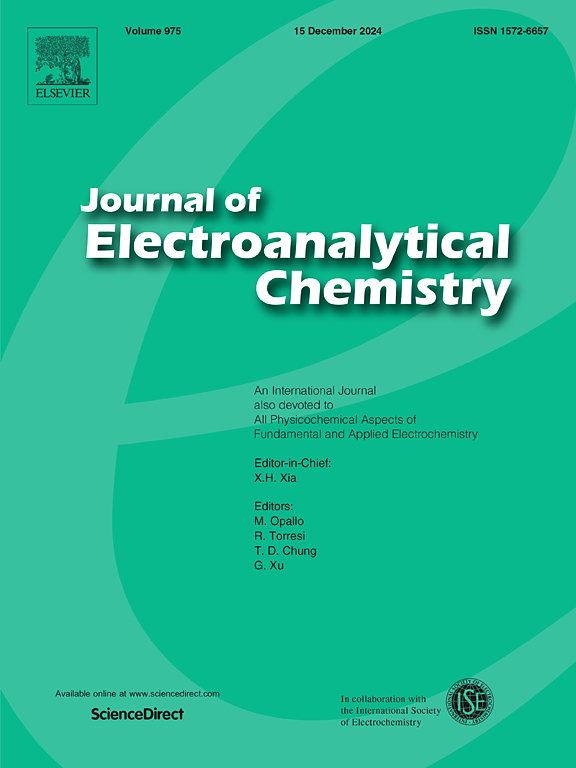Nanoconfinement-enchanced electrochemiluminescence based on a Ru(bpy)32+-loaded mesoporous silica nanoparticles for ribavirin detection
IF 4.1
3区 化学
Q1 CHEMISTRY, ANALYTICAL
引用次数: 0
Abstract
Testing ribavirin (RBV) is essential to promote its appropriate clinical use, mitigate resistance development, reduce adverse effects, and safeguard public health. Electrochemiluminescence (ECL) outperforms conventional methods in RBV detection, offering superior sensitivity and reduced background noise. In this work, ECL micro-reactors were prepared by incorporating Ru(bpy)32+ into a mesoporous silica matrix with two-dimensional hexagonal structure (SBA-15). In this configuration, tripropylamine (TPA) was employed as a co-reactant, which interacted with Ru(bpy)32+ to enhance the ECL signal. The quenching effect of ribavirin (RBV) on the Ru(bpy)32+-TPA system was confirmed through its significant suppression of ECL emission. A glassy carbon electrode (GCE) modified with SBA-15 loaded with Ru(bpy)32+ (SBA-15@Ru) was fabricated as a novel ECL sensor. This sensor enabled the detection of RBV over a wide concentration range 1.0 × 10−9 mol·L−1 to 1.0 × 10−5 mol·L−1, achieving a detection limit (LOD) of 3.33 × 10−10 mol·L−1. Additionally, the sensor exhibited outstanding stability and selectivity and was successfully applied for accurate quantification of RBV in pharmaceutical samples.
基于负载Ru(bpy)32+介孔二氧化硅纳米颗粒的纳米约束增强电化学发光检测利巴韦林
检测利巴韦林(RBV)对于促进其适当临床使用、减轻耐药性发展、减少不良反应和维护公众健康至关重要。电化学发光(ECL)在RBV检测中优于传统方法,具有更高的灵敏度和更低的背景噪声。在这项工作中,将Ru(bpy)32+掺入具有二维六边形结构的介孔二氧化硅基体(SBA-15)中制备了ECL微反应器。在这种结构中,三丙胺(TPA)作为助反应物,与Ru(bpy)32+相互作用以增强ECL信号。利巴韦林(RBV)对Ru(bpy)32+-TPA体系的猝灭作用通过其对ECL排放的显著抑制得到证实。制备了负载Ru(bpy)32+ (SBA-15@Ru)的SBA-15修饰的玻碳电极(GCE)作为一种新型ECL传感器。该传感器可在1.0 × 10−9 mol·L−1 ~ 1.0 × 10−5 mol·L−1的宽浓度范围内检测RBV,检出限(LOD)为3.33 × 10−10 mol·L−1。该传感器具有良好的稳定性和选择性,可用于药物样品中RBV的精确定量。
本文章由计算机程序翻译,如有差异,请以英文原文为准。
求助全文
约1分钟内获得全文
求助全文
来源期刊
CiteScore
7.80
自引率
6.70%
发文量
912
审稿时长
2.4 months
期刊介绍:
The Journal of Electroanalytical Chemistry is the foremost international journal devoted to the interdisciplinary subject of electrochemistry in all its aspects, theoretical as well as applied.
Electrochemistry is a wide ranging area that is in a state of continuous evolution. Rather than compiling a long list of topics covered by the Journal, the editors would like to draw particular attention to the key issues of novelty, topicality and quality. Papers should present new and interesting electrochemical science in a way that is accessible to the reader. The presentation and discussion should be at a level that is consistent with the international status of the Journal. Reports describing the application of well-established techniques to problems that are essentially technical will not be accepted. Similarly, papers that report observations but fail to provide adequate interpretation will be rejected by the Editors. Papers dealing with technical electrochemistry should be submitted to other specialist journals unless the authors can show that their work provides substantially new insights into electrochemical processes.

 求助内容:
求助内容: 应助结果提醒方式:
应助结果提醒方式:


